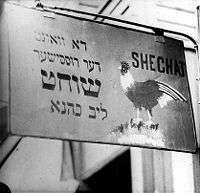The Ward, Toronto

The Ward (formally St. John's Ward) was a neighbourhood in central Toronto, Ontario, Canada.
It was bound by College Street, Queen Street, Yonge Street, and University Avenue and was centred on the intersection of Terauley (now Bay Street) and Albert Street. For several decades of the late nineteenth and early twentieth century, it was a highly dense mixed-used neighbourhood where successive waves of new immigrants would initially settle before establishing themselves. Characterized by authorities in the nineteenth century as a slum, it was the home of refugees from the European Revolutions of 1848, the Irish Potato Famine, the Underground Railroad, and then refugees from Russia and Eastern Europe. It was the centre of the city's Jewish community from the late nineteenth century until the 1920s when the Jewish community moved west to Spadina Avenue and Kensington Market and was also, until the late 1950s, the home of the city's original Chinatown, of many of the city's original Black residents centred on the British Methodist Episcopal Church, at 94 Chestnut Street, and of the city's Italian community until it moved west along College Street to Little Italy. The city's Polish, Ukrainian, Lithuanian, and numerous other non-Anglo-Saxon immigrants first established themselves in The Ward.
Today, the area is considered a part of what the City of Toronto now calls the Discovery District, the area having been consumed by the central business district. The old neighbourhood has wholly disappeared. The area was officially known as St. John's Ward,[1] one of the municipal wards that the city was divided into, but it quickly became known simply as "The Ward".[2]
History
In the 1830s, Thornton Blackburn—an African American fugitive slave—began acquiring several properties in the neighbourhood.[1] Blackburn also provided recently arrived fugitive slaves with inexpensive housing. By 1850, many Black families settled in The Ward; five years later, the total Black population grew to 539.[3][4]
The earliest Jewish settlers in Toronto had come from Britain, the United States, or Western Europe. With only a few hundred Jewish citizens in the city, they settled in several neighbourhoods and mostly integrated with the rest of the city. In the 1890s, an influx of Jewish immigration from Eastern Europe began arriving in Toronto. For the several thousand new arrivals, mostly impoverished and unable to speak English, the densely packed houses of The Ward became their new community.
The Ward was also home to Toronto's first Chinatown as Chinese railway workers settled along York and Elizabeth Streets north of Union Station.

The development of the neighbourhood caused much consternation in Toronto, including anti-Semitic riots and government clearance efforts. In 1909, 8 acres (0.032 km2) of The Ward were demolished to build the Toronto General Hospital. The neighbourhood also began to change in character. As the Jewish immigrants became more settled, they moved westwards to the Kensington Market area and the Ward increasingly became a centre for Italian immigrants, who were then arriving in great numbers. The Italians also moved west to what is today Little Italy, and by the Second World War, the Ward had become Toronto's first Chinatown. Central Neighbourhood House was established in 1911 as a settlement house to assist new immigrants in the Ward.

From the 1920s the Ward was slowly demolished as land was expropriated for office towers, hotels, and most prominently, the old Chinatown centred on Elizabeth Street was expropriated in the 1950s to make way for Nathan Phillips Square, named after a mayor of Toronto. For many decades, the area was almost wholly commercial and institutional, but recent years have seen a return of residents to what used to be the Ward with multiple condominium towers being erected in the area.
References
- 1 2 Escaped slaves helped build T.O.
- ↑ Introduction
- ↑ Underground Railroad Exhibit: Teacher Resources - Backgrounder to UGRR - Lesson Plan One
- ↑ Reverend Mitchell Harriet Tubman Institute. Accessed on February 28, 2016.
- - Toronto's First Synagogues - Dr. Stephen Speisman
- Historicist: Forgotten Urban Squalor of The Ward
Coordinates: 43°39′22″N 79°23′02″W / 43.656°N 79.384°W